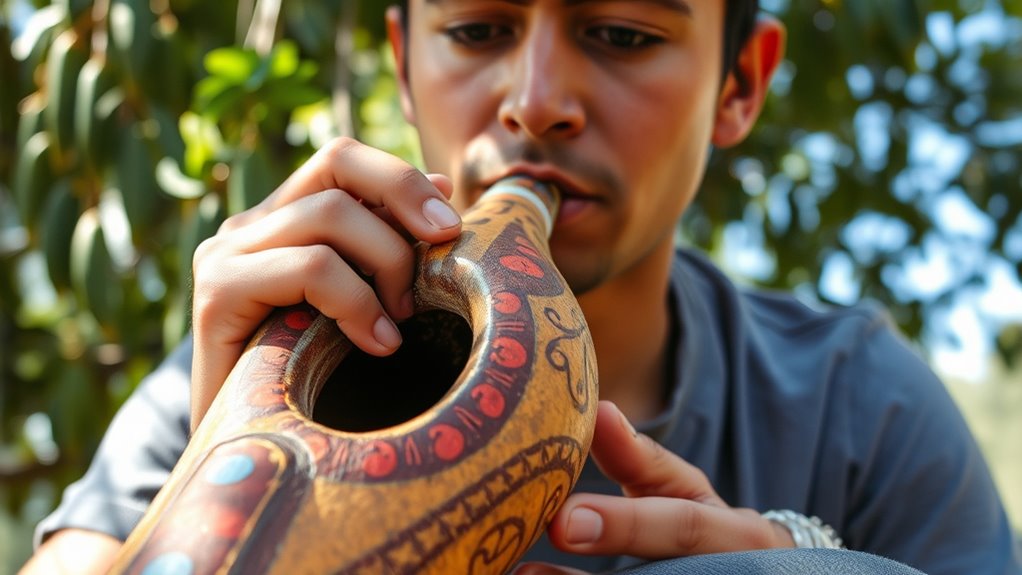To learn the didgeridoo, you should first understand its deep cultural roots in Aboriginal traditions, respecting its sacred significance. Focus on mastering techniques like circular breathing and breath control, while approaching practice with humility. Listening to skilled players can inspire your progress and help you grasp its expressive potential. Remember to honor the instrument’s history and consult Indigenous teachers when possible. Continue exploring these aspects to deepen your connection and skill with the didgeridoo.
Key Takeaways
- Understand the didgeridoo’s cultural significance and history within Indigenous Australian traditions.
- Practice circular breathing and mouth techniques to produce continuous, nuanced sounds.
- Respect the instrument’s sacred origins by learning from Indigenous teachers and embracing cultural etiquette.
- Listen to various players to gain insight into tone, rhythm, and expressive possibilities.
- Approach learning with humility, viewing the didgeridoo as a vessel for storytelling, spiritual connection, and cultural preservation.

Learning to play the didgeridoo can be an exciting and rewarding experience, even if you’re a complete beginner. This ancient instrument offers a unique way to explore musical expression, allowing you to produce deep, resonant sounds that can evoke powerful emotions. As you begin your journey, you’ll quickly realize that mastering the didgeridoo isn’t just about producing noise; it’s about connecting with a rich cultural significance that spans thousands of years. The didgeridoo is deeply rooted in Aboriginal Australian traditions, and understanding its cultural importance adds depth to your practice. Recognizing that you’re not just learning a musical instrument but also engaging with a sacred symbol of Indigenous heritage will deepen your respect and appreciation for its history.
Learning the didgeridoo connects you to a rich cultural heritage and deepens your musical expression.
Getting started involves familiarizing yourself with the basic techniques. You’ll want to focus on mastering the circular breathing method, which allows you to produce continuous sound without pause. This breathing technique can feel challenging at first, but with practice, it becomes more natural. As you work on your breath control, you’ll also experiment with different mouth shapes and tongue placements to vary your sound. Remember, the goal isn’t just to make noise but to develop a nuanced musical expression, where each tone and rhythm can convey emotion or storytelling.
It’s helpful to listen to traditional and contemporary didgeridoo players. This not only inspires you but also gives you insight into how different artists use tone, rhythm, and dynamics to enhance their musical expression. Watching videos or attending live performances—if possible—can give you a sense of the cultural significance behind the music. Many Indigenous players see the didgeridoo as more than an instrument; it’s a vessel for storytelling, spiritual connection, and community bonding. When you practice, keep this in mind. Respect for its origins and the cultural significance it holds is essential. If you’re learning from Indigenous teachers or community members, listen carefully and follow their guidance. Whether you’re playing for personal enjoyment or performing publicly, acknowledging the instrument’s sacred history enriches your experience. Over time, as you develop your skills, you’ll discover that playing the didgeridoo isn’t just about technical mastery—it’s about expressing yourself through a powerful, culturally meaningful sound that connects you to a centuries-old tradition.
Additionally, exploring cultural significance can deepen your appreciation for the instrument’s role in Indigenous communities and help you approach your practice with humility and respect.
Frequently Asked Questions
Can Beginners Learn to Play the Didgeridoo Quickly?
Yes, beginners can learn to play the didgeridoo quickly if you practice consistency and focus on beginner techniques. Regular, dedicated practice helps you develop your breath control and sound production faster. Start with simple exercises, stay patient, and keep practicing daily. While mastery takes time, consistent effort allows you to produce basic sounds and enjoy playing sooner. Remember, persistence is key to making quick progress.
Are There Different Didgeridoo Styles Based on Regions?
Think of didgeridoo styles like different flavors of a fruit; each region adds its own unique twist. Yes, regional variations exist, shaped by cultural influences from Aboriginal communities across Australia. These differences influence the instrument’s design, playing techniques, and sound. Exploring these regional styles lets you experience a rich tapestry of musical traditions, giving your playing depth and authenticity that reflects the diverse cultural roots of the didgeridoo.
How Do I Choose the Right Didgeridoo for Me?
To choose the right didgeridoo, consider material selection and sound quality. Pick a material that feels comfortable and suits your style, like bamboo for a warm tone or hardwood for durability. Test different sizes and shapes to find one that produces a rich, resonant sound you enjoy. Trust your ears and hands—your ideal didgeridoo should inspire you and match your playing preferences.
Is It Necessary to Take Lessons to Master the Instrument?
You don’t need formal lessons to master the didgeridoo. Many self-teaching options, like online tutorials and instructional videos, can guide you through techniques and practice routines. These resources allow you to learn at your own pace and reinforce proper playing methods. While lessons can be helpful, consistent practice using available online tools can help you develop your skills effectively and confidently, making mastering the didgeridoo accessible for everyone.
What Health Benefits Are Associated With Playing the Didgeridoo?
Playing the didgeridoo offers notable health benefits, much like the calming effects of meditation. You can experience improved respiratory health and find relief through didgeridoo therapy, which strengthens your breathing muscles and reduces snoring. Regular practice enhances lung capacity and oxygen flow, contributing to overall well-being. As with any mindful activity, consistent playing can support your health journey, making the didgeridoo a powerful tool for physical and mental wellness.
Conclusion
As you master the didgeridoo, remember that this ancient instrument holds more than just sound—it’s a bridge to Aboriginal culture and stories. Some believe playing it can heal and connect us to the earth, sparking a deep emotional bond. When you embrace its rhythms and traditions, you’re not just making music; you’re honoring a centuries-old legacy. Keep practicing, and let the didgeridoo reveal its profound power to you.









